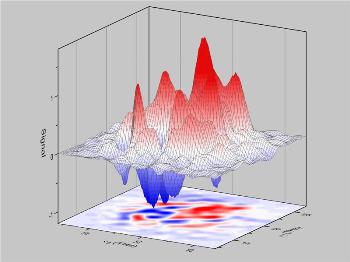Berlin researchers have demonstrated that semiconductor electrons are portrayed as a cloud measuring few nanometers in size when viewed using a novel type of spectroscopy. The size of the cloud is decided depending on the electron interaction with crystal lattice vibrations.
 Measured two-dimensional spectrum. Without the interaction of the electron with lattice vibrations there would be no signal in the range shown.
Measured two-dimensional spectrum. Without the interaction of the electron with lattice vibrations there would be no signal in the range shown.
In the recent issue published in the scientific journal, Physical Review Letters, researchers report that the electron-phonon’s interaction strength depends on the size of the electron, in other words, on the spatial extension of the electron charge cloud. Experiments within the lattice vibrations time range reveal that reduction in the size of the electron causes an interaction increase by a factor of up to 50. This leads to coupling of ions and electrons’ movements. Phonon and electron together create a unique quasi particle known as a polaron.
A nanostructure produced from gallium aluminum arsenide and gallium arsenide, in which the energies of the ions and electrons’ movements were tuned to one another, was utilized by researchers to observe this phenomenon. The coupling process of both ions and electrons’ movements were demonstrated using a novel optical technique. The system related to this study is excited by numerous ultra-short light pulses in the infrared. A real-time measurement of the subsequent light emission by the moving charge carriers is conducted. By this method, two-dimensional non-linear spectra were produced, which facilitate to determine the strength of the electron-phonon coupling and enable comprehensive examination of coupled transitions. By knowing the coupling strength, the electron cloud size can be determined which is only 3 to 4 nm. In addition, this method depicts how important the electron-phonon coupling is for semiconductors’ optical spectra. This enhances the creation of optoelectronic devices enriched with electric and optical properties.